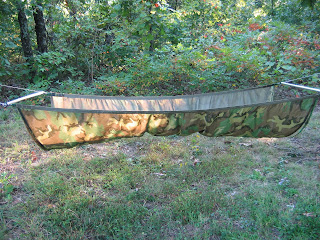
There is a camping area and no camping is allowed outside of designated camping spots. That makes transportation easy. We didn't have to hike in and search for a place to set up camp. we just hung the hammocks right next to our car. I think it was probably the prettiest day of the year in terms of fall colors. The pictures don't really do it justice.


The downside of "car camping" like this (as opposed to backcountry camping which is what I think backpacking is all about) is that you are stuck next to a bunch of other car campers who have come mostly to drink beer and talk loudly until late hours. So you don't sleep well in these sites. When we arrived we got out of the car and a neighboring camper was blasting techno music. Not exactly the what you expect when camping in the Ozarks is it?
I bought an ultralight pack for younger kids to use when they come camping with me (the older ones can use the G5). It's an REI Flash UL. It's designed to be a daypack but it works as a lightweight frameless pack for a kid. It's simple and lightweight and the price is right.

This is a hammock that I made for a kid to use when they come hiking with me. It took like 5 minutes to make and $15 of material from Walmart. I followed the directions for Risk's Test Hammock. He says it should cost only $9 but I think webbing is more expensive than when he wrote the directions. The material is from the $1/yard bin.

My son Hyrum is the world's pickiest eater. But there is one backpacking meal he likes and it's one of my favorites as well. It's Mary Janes Farm Organic Black Beans and Rice. I find it takes a bit more water than the directions call for. But it's excellent stuff to eat with chips.

Now I had hiked part of the Courtois Creek section of the Ozark trail during the summer but part of the trail was overgrow and I got lost and had to bushwhack until I found the nearby road which I followed to the campground (If I'd been paying better attention to my map and compass it wouldn't have happened). Ironically that mistake caused me to miss the best part of the trail. So this time Hyrum and I set out to fill in that gap. The stretch I missed is only about a mile long so we left our packs at camp and just walked it after breakfast.
This section of trail is unbelievably gorgeous, especially on a crisp autumn day like we enjoyed. The pictures really don't do it justice.

The trail leads between a sheer cliff that rises on one hand and the creek on the other. If you look back at the map we camped about where the "P" is and then followed the trail (shown in red) to the northeast next to the creek and then did one or two switchbacks as we climbed out of the valley.



There are many caves in the cliff beside the path and some of them go back quite a ways. We went into this one and followed it back until it began to get too dark for us to see, then we chickened out and headed back out.

Once we climbed out of the valley we wanted to head back to camp. Rather than reversing our steps we followed a path along the top of the cliff. It's kind of hard to see what's going on in this picture but it's a view of the path by the creek taken from directly above.

Here's one we did to give Hyrum's mother a heart attack. Hyrum is dangling his feet over the cliff. As you can see he was a little nervous about the height as well.

All in all we had a very nice trip. Not as much hiking as I'd like but that's they way it goes when I bring little ones along.
I did learn something. I designed my quilt to be good down to 40 degrees. I found out on this trip that that was pretty accurate because it dropped into the 30s and I was cold during the night! We've now got some material to make a 20 degree quilt. But what I really want is something for my feet. The rest of me was pretty good but even after I put on a second pair of wool socks my toes were cold. I think next time I'm going to try a vapor barrier inside my socks. I'll explain more about that after I try it.























